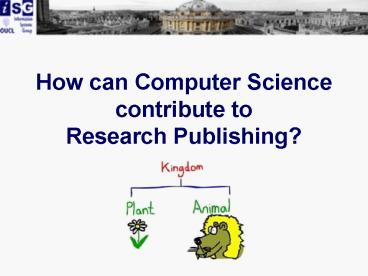How can Computer Science contribute to Research Publishing PowerPoint PPT Presentation
1 / 24
Title: How can Computer Science contribute to Research Publishing
1
How can Computer Science contribute to Research
Publishing?
2
Introduction to KRR Group
3
Who are we?
- Academics
- Ian Horrocks
- A. N. Other
- Research Students
- Héctor Pérez-Urbina
- Rob Shearer
- Research Staff
- Bernardo Cuenca Grau
- Birte Glimm
- Yevgeny Kazakov
- Boris Motik
- Rob Shearer
4
What Do We Do?
- Knowledge representation (obviously)
- Ontologies and ontology languages
- Description logics
- Formal underpinnings of ontology languages
- Reasoning problems and algorithms
- Implementation and optimisation of reasoning
systems
5
Relevance to Publishing?
6
Annotations
- Key role will be played by annotations
7
Annotations
- Key role will be played by annotations
- But how can meaning be understood by software?
Now... that should clear up a few things around
here
8
Annotation Semantics
- Agree on meaning of a set of terms
- E.g., Dublin Core
- Limited flexibility and extensibility
- Limited number of things can be expressed
- Agree on language used to define meanings
- E.g., an ontology language
- Flexible and extensible
- New terms can be formed by combining existing
ones - Meaning (semantics) of such terms is formally
specified
9
What is an Ontology?
- A model of (some aspect of) the world
- Introduces vocabulary relevant to domain
- Often includes names for classes and
relationships - Specifies intended meaning of vocabulary
- Typically formalised using a suitable logic
- Closely related to schemas in the DB world
- Instantiated by set of individuals and relations
- Defines constraints on possible instantiations
10
(No Transcript)
11
Supporting Ontology Engineering
- Developing and maintaining quality ontolgies is
very challenging - Users need tools and services, e.g., to help
check if ontology is - Meaningful all named classes can have instances
12
Supporting Ontology Engineering
- Developing and maintaining quality ontolgies is
very challenging - Users need tools and services, e.g., to help
check if ontology is - Meaningful all named classes can have instances
- Correct captures intuitions of domain experts
13
Supporting Ontology Engineering
- Developing and maintaining quality ontolgies is
very challenging - Users need tools and services, e.g., to help
check if ontology is - Meaningful all named classes can have instances
- Correct captures intuitions of domain experts
- Minimally redundant no unintended synonyms
?
Banana split
Banana sundae
14
Supporting Ontology Engineering
- Range of new non-standard services supporting,
e.g. - Error diagnosis and repair
15
Supporting Ontology Engineering
- Range of new non-standard services supporting,
e.g. - Error diagnosis and repair
- Modular design and integration
- What is the effect of merging O2 into O1?
- Module Extraction
- Extract a (small) module from O capturing all
relevant information about some vocabulary V - Bottom-up design
- Find a (small and specific) concept describing a
set of individuals
16
Supporting Query Answering
- In an Ontology based Information System
(OIS),Query answering ¼ computing logical
entailment - Reasoner needed in order to answer queries, e.g.
- C is a sub-class of D iff O ² 8 x . C(x) ! D(x)
- a is an instance of C iff O ² C(a)
- OIS with no reasoner ¼ DBMS with no query engine
17
Information Integration
- Ontologies provide unifying schema
- Bridging between different data sources
- Query answering w.r.t.ontology
- Date retrieved from relevant sources
- Similar to data integration in DBs
- More flexible
- Deductive capabilities
18
Driving User Interfaces
- Interface reflects structure of knowledge
- Query by navigation
- Semantically meaningful presentation of data
- Easier understanding
- Context aware
19
Research Themes
20
Ontology Languages
- Standards crucial
- Interoperability
- Tool support
- W3C OWL ontology language standard
- Central role in development of OWL language
- Leading development of OWL 2
- Extension to OWL driven by application
requirements - OWL 3?
- Graphs
- Integrity constraints
21
Scalability
- Integration of DLs with DBs
- Tractable ontology languages
- Lightweight languages for data-intensive
applications - Reasoning can be reduced to SQL querying
- New HermiT DL reasoner
- Implements optimised hypertableau algorithm
- Already outperforms existing reasoners
- Aim is to push the limits of practical reasoning
22
New Reasoning Services
- Integration extraction of modules
- Algorithms and practical techniques
- Incremental reasoning
- Methodologies and tool support
23
New Reasoning Services
- Conjunctive query answering
- Views
- Definition and application in ontologies
- Algorithms and tool support
- Information hiding and privacy
- Lift/transform ideas from DB research
- Reformulate as reasoning problems
24
Thank you for listening
Any questions?

